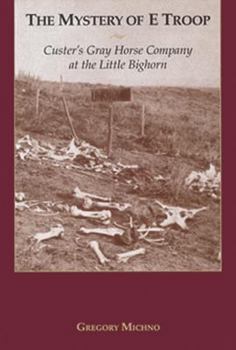Mystery of E Troop
Select Format
Select Condition 
Book Overview
The men of Company E rode big gray horses that stood out amidst the confusion during the afternoon of June 25, 1876. Twenty-eight of these men were found dead in a ravine after the fighting ceased. But which ravine? Why couldn't the army find their bones only a few years later? Why didn't archaeological excavations uncover any remains? The answers, finally, are at hand.
Format:Paperback
Language:English
ISBN:0878423044
ISBN13:9780878423040
Release Date:June 1994
Publisher:Mountain Press
Length:368 Pages
Weight:1.32 lbs.
Dimensions:1.1" x 6.0" x 9.0"
Customer Reviews
5 ratings
Some Mystique Demystified
Published by Thriftbooks.com User , 15 years ago
In this precursor to his outstanding Lakota Noon, Michno has the courage to challenge the methods and conclusions of a number of respected LBH writers. He points out weaknesses and inconsistencies, and supports his challenge with evidence and witness statements. The structure of this book allows him to construct a point of view then and build a compelling momentum from chapter to chapter. A very strong addition to my Custer shelf is recommended to yours.
Great research and logical reasoning
Published by Thriftbooks.com User , 17 years ago
Gregory Michno has shown time and again that he will follow the evidence in a logical way, and will not let emotions or current fashion get in his way. This book is a great example of his methods, as he uses Indian accounts and Soldier accounts of the Battle of the Little Bighorn to discover where the bodies of E Troop fell. The controversy is about whether the bodies were found in Deep Ravine or in what is known as Cemetery Ravine, and it involves how accurately the white stone markers are placed throughout the battlefield, especially in the area of these two Ravines. The beauty of the book is that although Michno is focusing on the whereabouts and demise of a certain group of soldiers, (E Troop), the first hand accounts and research give the reader a unique insight into the whole battle from start to finish, and a good understanding of how the battlefield was preserved in the months and years following the fight. This book is a very important addition to my western library concerning the history of George Custer.
excellent read
Published by Thriftbooks.com User , 20 years ago
I have only recently begun reading on Custer and the Little Big Horn. I started with Dr. Fox's work and I have been reading backwords as much as I can. Michno's work is excellent and offers many new views on Custer and the battle and I am sure his views will stur up some thought. I strongly suggest everyone read this work and his others. I am convienced he is correct in his views, and his conclusions I completely agree, no other Custer work has been as good as this one. I am an ex combat soldier and served in many a scrap, I can readdly se and understand the mess Custer got himself into. I hink you will really enjoy this read.
For the non-expert this can be a little overwhelming
Published by Thriftbooks.com User , 25 years ago
This book is well researched and well written. However, if you have just a passing interest in the Battle of the Little Bighorn, or have just begun your reading on the subject, this is not for you. In an effort to solve the mystery of 28 troopers who apparently died in Deep Ravine, but whose bodies are said to have never been found, Michno provides innumerable eye-witness accounts both white and Indian. In the beginning I tried to follow all of them, especially since I had just been to the battlefield, but I soon found it far too cumbersome. Mr. Michno has put alot of work into this, and he deserves recognition for it, however I would recommend this book only for people who already have a very detailed knowlege of the subject. END
An important contribution to study of the Little Big Horn
Published by Thriftbooks.com User , 28 years ago
Michno has performed a meticulous analysis of all available evidence about the fate of one company of the Seventh Cavalry during the Battle of the Little Bighorn. Many students of this famous Indian fight have contended that these soldiers had been killed in the bottom of a narrow ravine on the Custer battlefield, their remains now either buried by erosion or washed away. Michno presents a convincing case that this view is erroneous due to mis- interpretation of the evidence and makes a persuasive arguement that these graves are in fact well-marked on another part of the battlefield. Michno has made an important contribution to the tactical understanding of this most famous of the Indian Wars battles.






